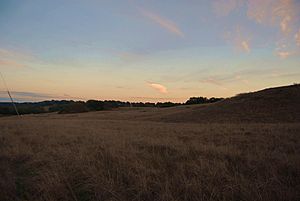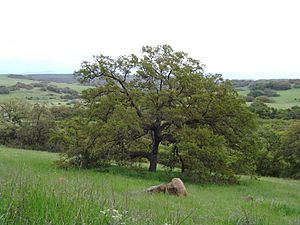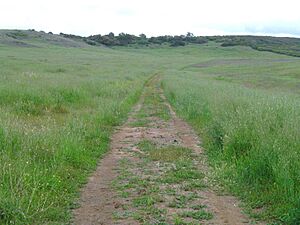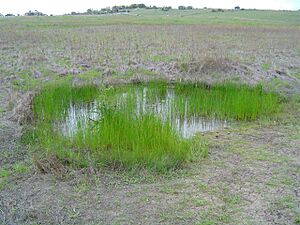Santa Rosa Plateau facts for kids

The Santa Rosa Plateau is a special upland area in Riverside County, southern California. It's like a high, flat land that extends from the Santa Ana Mountains. Cities like Murrieta and Temecula are nearby.
A big part of this plateau is protected as the Santa Rosa Plateau Ecological Reserve. This reserve covers about 8,400 acres (34 km²). It's home to some very old buildings, like the Moreno and Machado Adobes. These are the oldest standing structures in Riverside County, dating back to the 1800s. They were part of a large Mexican land grant called Rancho Santa Rosa.
Contents
- Discovering Habitats at Santa Rosa Plateau
- Exploring the Santa Rosa Plateau Ecological Reserve
- Amazing Flowers of the Reserve
- Mammals of the Plateau
- Birds of the Reserve
- Reptiles of the Plateau
- Amphibians of the Reserve
- Geology: The Rocks of the Plateau
- Lichen: A Teamwork Organism
- Human History of the Plateau
Discovering Habitats at Santa Rosa Plateau
The Santa Rosa Plateau is like a natural treasure chest, full of different plant communities and habitats. You can find unique areas here that are becoming rare in busy Southern California.
One important habitat is the purple needlegrass prairie. This is a type of grassland with a special native grass. There are also California oak woodlands, especially with Engelmann oaks (Quercus engelmannii). These oaks are very special because the reserve has the only protected, reproducing Engelmann oaks in the state. They used to grow much further north, but now Pasadena is their northernmost natural home.
Other habitats include montane chaparral and coastal sage scrub.
What are Vernal Pools?
One of the most unique habitats here are the vernal pools. Imagine a shallow dip in the ground that fills with water when it rains in spring. These pools are temporary.
Tiny creatures like fairy shrimp hatch in these pools when they are wet. They lay eggs that can survive the dry summer months. When the rains return, the eggs hatch again, and the cycle continues!
Exploring the Santa Rosa Plateau Ecological Reserve
The Santa Rosa Plateau Ecological Reserve was created step-by-step. In 1984, The Nature Conservancy bought two large pieces of land, totaling 3,100 acres (13 km²). Later, in the 1990s, other parts were purchased by the State of California, the Riverside County Regional Park and Open-Space District, and the Metropolitan Water District of Southern California.
Even though different groups own the land, they all work together to manage it. The Nature Conservancy helps with protecting the plants and animals. This includes using controlled fires and restoring habitats. Riverside County Parks manages visitors, running a visitor center and a 40-mile (64 km) trail system.
A non-profit group, the Santa Rosa Plateau Nature Education Foundation, helps local third-graders visit the Reserve. They provide money for field trips so kids can learn about nature.
Amazing Flowers of the Reserve
The Reserve is home to many beautiful flowers. In March 1998, people reported seeing 50 different kinds of wildflowers blooming at once!
The best time to see the flowers is in the spring. The Vernal Pool Trail is a great place to spot them. One very special flower that people come to see is the Chocolate Lily. You can often find it in April on the slopes near the vernal pools.
As the vernal pools start to dry up, flowers grow in circles around them. The most common flower you'll see around the pools is the bright California poppy.
Mammals of the Plateau
The Reserve is home to 27 different kinds of mammals. This includes 12 types of rodents. Some of the mammals you might find are:
Most mammals here are nocturnal, meaning they are active at night. This makes them hard to spot for visitors. However, ground squirrels are active during the day and are often seen. Coyotes and mule deer are also sometimes seen by visitors.
Birds of the Reserve
Over 185 different types of birds have been seen at the Reserve! Many large birds build their nests here. These include:
- Mallards
- Black-shouldered kites
- Cooper's hawks
- Red-shouldered hawks
- Golden eagles
- American kestrels
Barn owls and great-horned owls also nest on the site.
You can find Anna's hummingbirds all year round. Black-chinned hummingbirds are common in spring and summer. If you hear a knocking sound on wood, it might be an acorn woodpecker. If you hear a sound like a laugh, it could be a northern flicker. A rustling in the bushes might be a rufous-sided towhee looking for insects.
Reptiles of the Plateau
The Reserve is an important home for the Southwestern pond turtle. These turtles are a "Species of Special Concern," meaning they need protection. It is against the rules to take them from their habitat.
These turtles can grow to about five and a half inches long. When wet, they are dark, which helps them blend in with mud at the bottom of ponds. They have webbed feet for swimming and claws for digging nests. They mostly eat small water creatures. They spend most of their lives underwater, where they also mate. They come out of the water daily to warm up in the sun. Sadly, in southern California, pond turtle numbers have dropped a lot. The Reserve is one of the few places where these turtles are still successfully reproducing.
Other reptiles found here include various snakes and lizards:
- Snakes: San Bernardino ring-necked snake, Hammond's two-striped garter snake, coastal rosy boa, red diamond rattlesnake, Southern Pacific rattlesnake, California kingsnake.
- Lizards: San Diego horned lizard, western fence lizard, granite spiny lizard, side-blotched lizard, western skink, western whiptail, San Diego alligator lizard.
Amphibians of the Reserve
Amphibians found on the Reserve include:
- Coast range newt
- Garden slender salamander
- Black-bellied salamander
- Western spadefoot toad
- Pacific treefrog
- California red-legged frog
However, bullfrogs are also found here. Bullfrogs are an invasive species. This means they are not native to the area and can take over territory from native species because they are much larger.
Geology: The Rocks of the Plateau
The rocks at the Reserve tell a long story about Earth's history. The oldest rocks are meta-volcanic rocks, formed about 220-190 million years ago. Above them are meta-sedimentary rocks, including slates and limestone.
Gabbro, a type of rock made of feldspar, pyroxene, and olivine, formed about 143-101 million years ago. Granite rocks arrived about 119-105 million years ago. Sand and gravel were laid down by flowing water about 23-9 million years ago. Finally, olivine basalt formed from a lava flow about 9-6 million years ago.
Lichen: A Teamwork Organism
You can find different types of lichen on the rocks at the Reserve. Lichen are not a single plant, but a special team-up between a fungus and an algae. The fungus provides the structure, and the algae makes food for both of them.
Common lichen species found on large rock formations include common greenshield lichen, beaded rosette lichen, sunken disk lichen, and rim lichen.
Human History of the Plateau
People have lived in this area for a very long time, over 8,000 years! The Native Americans known as the Luiseno people are thought to have arrived about 1,500 years ago. They were called Luiseno because of their connection to the San Luis Rey Mission.
It's believed they used the Plateau mainly during warm weather and in the fall to gather acorns. The rest of the year, they lived in what is now the Temecula Valley. They had a village called Meha on the Plateau. Evidence suggests this village was used for about 6,000 years. When you visit the old adobe buildings, you can still see marks in boulders where Native Americans ground acorns and other foods.
Before missionaries arrived, these groups lived in separate areas but traded and had ceremonies together. They would go to the mountains to gather acorns, especially from black oak trees. In winter, they traditionally moved closer to the coast.
In 1798, the San Diego mission decided to build a new mission between San Diego and San Juan Capistrano. This became Mission San Luis Rey de Francia. All Native Americans under this new mission's control were called Luiseno.
When Spanish rule ended in 1822, the new Mexican government decided to take mission lands away from the church. This happened in California in 1834. It was around this time that the plateau got its name, probably honoring Saint Rose of Lima.
In 1846, a man named Juan Moreno was given a huge land grant of 47,000 acres by the Mexican governor. In 1855, Moreno sold this land, called Rancho Santa Rosa, to Augustin Machado. After Machado passed away, the land changed hands several times.
Later, in 1904, Walter Vail bought the land mainly to raise cattle. When he died, his son, Mahlon Vail, took over. Mahlon Vail was known for respecting the Native Americans' rights to gather acorns, wood, and hunt on the Plateau. However, they were not allowed to live with the other cowboys and had to live off the ranch.




